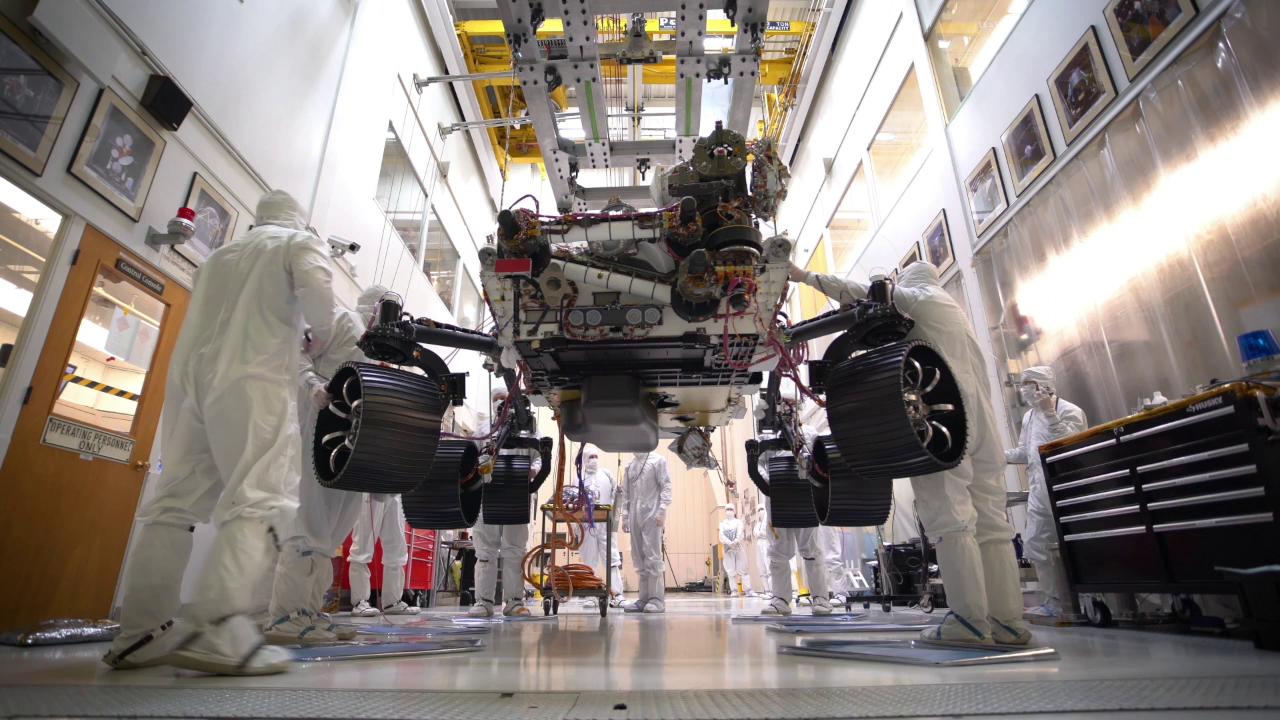This coming July, the Mars 2020 rover will launch from Cape Canaveral, Florida, and begin its journey to the Red Planet. After it touches down in the Jezero Crater, the rover will commence science operations similar to what Curiosity has been doing since 2012. This will consist of driving over rough terrain, sampling the atmosphere, collecting drill samples, and subjecting them to chemical analysis.
In order to get it ready for this mission, the engineering team over at NASA’s Jet Propulsion Laboratory are putting the rover through its paces. On Oct. 8th, this included placing the full weight of the rover on its legs and wheels for the first time ever. This event, which was tantamount to an infant standing for the very first time, was captured with a time-lapse video that you can see below.
Supporting its own weight is no easy task, since the rover weighs just over a metric ton – or 1,050 kg (2,315 lb), to be exact. Like its sister-rover Curiosity, the job of carrying this weight is done by six aluminum wheels that are connected to its main body with titanium legs. Each wheel has traction-providing cleats (or grousers) that allow the rover to drive and maneuver over Mars’ rough terrain.
As Ben Riggs, a mechanical systems engineer working on Mars 2020 at JPL, said in a recent NASA press statement:
“After years of design, analysis and testing, it is fantastic to see the rover on her wheels for the first time. The whole team looks forward to seeing her in the same configuration on Mars in the not too distant future.”
The rover’s design incorporates a novel suspension system that consists of multiple pivot points and struts – known as a “rocker-bogie” system. This allows the rover to maintain stability by keeping a relatively constant and equal distribution of weight on each wheel. This also allows the rover to roll over obstacles and depressions that are the same size as its wheels.
The wheels also come with individual steering motors that enable the rover to rotate a full 360 degrees in place, giving it added maneuverability in tough terrain. While the rover can be driven while at a 45-degree tilt in any direction (without tipping over), the drivers will be avoiding terrain that is tilted more than 30 degrees.

The photographs that went into the time-lapse video were all taken from inside the JPL Simulator Building, where the Mars 2020 rover has spent the past few weeks undergoing testing. This has included an extensive evaluation of how its instruments, systems, and subsystems will operate in the Martian environment – which is characterized by extreme temperatures and near-vacuum conditions.
When the time comes, the rover will launch from NASA’s Space Launch Complex 41 at Cape Canaveral Air Force Station atop a United Launch Alliance Atlas V rocket. The mission will arrive on Mars by Feb. 18th, 2021, where it will begin exploring the Jezero Crater for additional evidence of Mars’ watery past and collect samples for eventual return to Earth.
It is also hoped that the rover will find conclusive evidence about past (and maybe even present) life on Mars. In addition to settling a debate that has raged since the Viking 1 and 2 missions sent landers there in the mid-1970s, it will finally prove beyond a shadow of a doubt that life does exist beyond Earth!
In the meantime, there’s still a chance to name the Mars 2020. Head on over to the NASA website to make your pitch!
Further Reading: NASA

